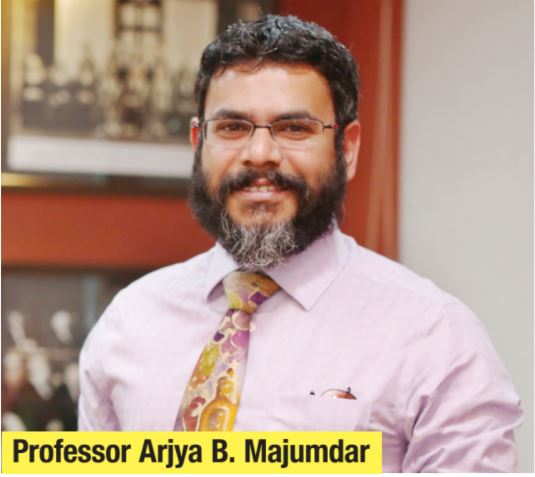 – Professor Arjya B. Majumdar, Dean, Admissions & Outreach, O.P. Jindal Global University
– Professor Arjya B. Majumdar, Dean, Admissions & Outreach, O.P. Jindal Global University
The deadly new wave of the Covid-19 pandemic that is ravaging India has brought us face-to-face with the dangers of not paying enough attention to building robust healthcare infrastructure. As images of people scrambling to get a hospital bed or an oxygen cylinder for their loved ones overwhelm us with grief, they also tell us to introspect where we, as a society, went wrong.
Does this catastrophic lack of foresightedness stem solely from misgovernance? Or does it run deeper into the philosophies that govern us as a civilisation? Why don’t we have the basic preparedness to deal with a pandemic like this in this 21st century? The pandemic has revealed cracks in both the metaphorical building blocks of our nation and quite literally, the “built environment” around us.
This built environment that lays the foundation for human life—from buildings to open spaces, parks, streets and so on—is simply not prepared for a pandemic. Big corporate offices are becoming redundant; densely-packed spaces are leading to a faster spread of the virus; many living spaces are strained to accommodate the “new normal”; sewage systems, transport systems, public spaces, and so many more aspects that touch our everyday lives are facing serious challenges.
Alongside the healthcare crisis, the ways in which we live, work, learn and play have been dramatically disrupted. As concepts like “social distancing” or “work from home” and “online classes” have woven their way into the foreseeable future, people are faced with struggles every step of the way.
We must wonder, then, how our homes, hospitals, schools, and our cities, towns, villages and neighbourhoods have been built until now—and how they can evolve to be resilient to the dangers of a pandemic. For experts have already warned that Covid-19 will definitively not be the last pandemic that the world will fight. So, the message is clear. Even after we overcome this, the threat of another pandemic still looms large.
Lessons from the pandemic suggest that the edifice of the future built environment must be created on the foundation of dignity, care and harmony with nature, not just convenience, efficiency and economy of space. Architects across the globe are reckoning with the pitfalls of the built environment, as they are pushed to reimagine a new approach. So formidable has been the impact of Covid-19 that the road ahead will require people to look at everything from the vantage point of safety and sustainability. Simple changes in the built environment to paradigm shifts in design thinking can together build sustainable solutions.
How should we start then? The scope that educational institutions have in this regard is immense. As a leading private university in the country, O.P. Jindal Global University (JGU) has taken many steps that prepare our students for dynamic, unpredictable times.
The unique offering of Jindal School of Art and Architecture (JSAA), as India’s first interdisciplinary school of the built environment, is one such step that is immensely relevant to today’s context. Through its various programmes in architecture, built environment, and design, JSAA has the capability to train young minds to navigate the challenges of pandemicproofing the built environment of the future.
JSAA’s curriculum has been developed keeping in mind the need to study architecture and the built environment from the perspective of social sciences and humanities. This is because the built environment needs to combine design thinking and engineering brilliance with elements of care and thoughtful considerations to withstand complex problems like a pandemic.
The mess that our cities have become amid the pandemic only validates the wisdom of that vision. No one can deny the need to make our spaces functional even during such difficult times. To achieve that, we will have to reimagine the spaces that we use. We will have to make them more humane. For, a built environment that is humane need not render an elderly person or a young one completely idle even during a possible temporary isolation period during a future pandemic or drive the migrant labourers out of the city when a lockdown is announced.
Students of JSAA will not only learn the fundamentals of architecture and design, but they will also get to know the nuances of legality, policy-making, environmental issues, questions of economics, technology, sustainability and ecology. After all, an architect who ignores the relevance of variables outside of aesthetics, engineering or economics alone, cannot really be capable of building a truly sustainable world. It is a holistic, multidisciplinary education that has the potential to combine and create knowledge from different perspectives that could pre-empt some of the consequences of such crisis.
It is worth mentioning that faculty at JSAA comprises a pool of globally qualified academicians and professionals from different domains. Architects, historians, engineers, geographers, lawyers, artists, conservationists and more work in tandem to guide students to become agents of change who can question the status quo and reshape the world in the face of unprecedented challenges.
At JSAA, students work on live projects, thereby gaining hands-on experiences that offer a chance to make a real impact in the real world. Internship opportunities in global firms will further bolster their confidence to become changemakers when they enter the job market or pursue higher education.
As the ongoing pandemic changes the course of architecture, JSAA offers a platform for young people to become a part of rewriting the narrative of the built environment of the future, to come together and build a more resilient world that can be better prepared to deal with a pandemic.























